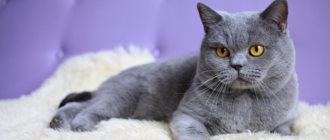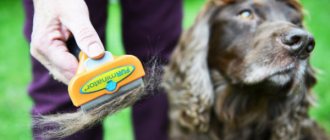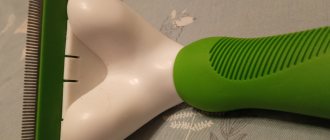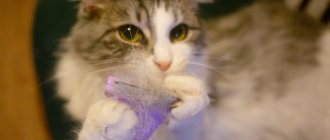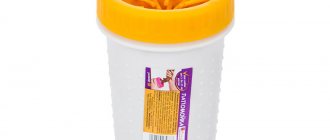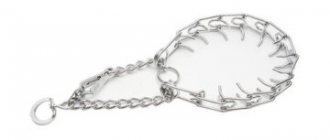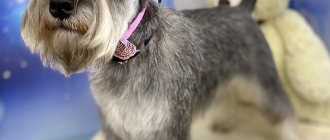Almost all dog breeds, with the exception of just a few, require constant coat care. Depending on the length and thickness of the fur, this process can be complex and time-consuming. Not all dogs are favorable to the combing procedure; sometimes owners have to resort to all sorts of tricks and tricks. In order to make grooming as effective and comfortable for the animal as possible, there are various devices - special combs for dogs, brushes, gloves.
What is a furminator: appearance and principle of operation
This term refers to a grooming accessory that resembles a razor in its shape. It consists of a rubberized handle and metal blades with rounded teeth.
Unlike other dog combs, the Furminator only captures the undercoat and dead hairs. He carefully pulls them out without cutting off the guard hairs or tearing out healthy hair follicles.
Process Features
Combing removes dead hairs, traces of insects, debris or street dirt from the dog's fur. The procedure is also important for health, as it massages the pet’s skin well, improving blood circulation and smoothing out subcutaneous fat.
You should also understand that a well-groomed dog practically does not shed hair and does not create difficulties when cleaning the home.
What is it intended for and who is it suitable for?
The tool is designed to prevent tangles and reduce the duration of seasonal shedding. It quickly removes accumulated fluff without causing pain or discomfort to the animal.
The device is suitable for breeds with a thick and well-developed undercoat:
- setters;
- husky;
- bobtails;
- spaniels;
- shepherd dogs;
- retrievers;
- St. Bernards;
- huskies.
By combing out excess hair, natural heat exchange is maintained and new hair growth is stimulated. This eliminates overheating in hot weather or hypothermia in the cold season.
Dog with medium long hair
Medium length coats are typical for Labradors and Rottweilers.
- Experienced breeders advise how to properly comb a dog during shedding: With a special thick comb and as often as possible (preferably every other day).
- In normal times, it is better to tidy medium-length wool with a semi-soft rubber comb.
When not to use the tool
Despite its advantages, the accessory also has a number of contraindications. Restrictions on use are imposed if the coat type is unsuitable and in the presence of certain diseases or injuries.
Breeds that should not be scratched with a furminator
It is prohibited to comb animals with long, thin and silky hair, such as lapdogs, Yorkies, Shih Tzus and Afghan hounds. Blades of such great length are simply not available.
Also, you should not use the tool if the dog has curly and rough fur (poodles, Airedales, Komondors). When combing, it catches and smoothes the hairs, removing the curls inherent in the breed.
The main task of the product is to remove undercoat. For this reason, it is simply pointless to use it for combing smooth-haired (dachshunds, bulldogs, Dobermans) and completely hairless (Chinese Crested, Peruvian dogs) breeds.
Temporary contraindications
Temporary contraindications include multiple tangles, any damage to the skin and dermatological diseases. If your pet is injured or suffers from eczema, postpone brushing until it recovers. Otherwise, you will only hurt him and make the existing problem worse.
What are they?
To make your pet look well-groomed, you need to brush it regularly. During this procedure, dust, dirt and dead hairs are removed from the fur. Combed fur looks much more elegant than uncombed fur, and the procedure itself, if done correctly, is also a massage for the pet’s skin. And during the molting period, combing becomes a necessary procedure, since otherwise the whole house is strewn with fallen hair.
When choosing a comb, you should focus on your pet's coat type.
Based on coat type, dogs are divided into:
- smooth-haired (pug, boxer, great dane, etc.)
- straight-haired (Rottweiler, Labrador, Akita, Beagle and others)
- wirehaired (many terriers, griffins, schnauzers)
- medium-haired (Pekingese, collie, Spitz, Samoyed, Caucasian Shepherd, etc.)
- long-haired (Yorkie, Lhasa Apso, Maltese, etc.)
- long-haired with corded hair (komondor, corded poodle, puli)
- soft-haired (poodle, bichon, bedlington terrier, etc.)
- hairless (hairless Mexican, Chinese crested)
Smooth-haired dachshund
Corded Poodle
Dogs with different coat types require different care: for some, brushing with a massage brush once a day is enough, while others need long and thorough combing, as well as complex haircuts and grooming.
To achieve a good result, you should buy only high-quality combs for dogs, and this is best done in specialized stores.
ATTENTION! You can’t limit yourself to just one comb: to tidy up the coat of a long-haired or wire-haired dog, you use several combs and brushes that differ in shape and size of teeth.
Device types
Tools differ from each other not only by manufacturer, but also by other criteria. When purchasing, it is important to consider the size of the animal and the length of the coat, as these factors affect the length and shape of the teeth.
Depending on the size of the pet
Basic models are presented in only 3 types. These include:
- Small. Equipped with a blade up to 4.5 cm. Designed for small short-haired dogs. The weight of the animal should be between 5-9 kg.
- Medium. A universal option with 6-7 cm blades, suitable for most four-legged animals weighing 10-25 kg.
- Large. This Furminator is recommended for large dogs weighing 25-40 kg. The length of the blades is 10-10.5 cm.
Owners of dwarf and giant breeds will have a little more difficult time. For their pets, the rarer Extra-small, or X-small, and Extra-large, or X-large models are suitable. The length of their blades is 3 and 12.5 cm, respectively. The first option is recommended for animals weighing less than 5 kg, and the second for animals weighing more than 40 kg.
Depending on the pet's fur
In addition to the listed models, there are two more types: Long and Short. The first has elongated and sparsely spaced teeth, while the second has shortened and tightly adjacent teeth.
“
The choice depends on the length of the dog's coat. If it exceeds 5 cm, take Long, and if it is short enough, give preference to Short.
Please note that the line of accessories called FURminator FURflex fits any length. This option will be useful for owners of several pets with fur of different lengths. To save money, you can take only one tool for all four-legged animals.
Tools and accessories
To ensure that grooming procedures are not a burden, but rather cause pleasure for both the pet and the owner, you need to know how to comb the dog’s fur as effectively as possible. For this, a lot of different tools are offered: combs, slicker brushes, devices for cutting out tangles and much more.
The most common and accessible tool for combing is a special comb for dogs. A seemingly simple item must meet certain requirements:
- The teeth should be blunt so as not to injure the animal’s skin;
- The length of the teeth should not exceed the length of the hairs of the coat;
- It is advisable to have two combs - for the initial combing of matted fur and for adding beauty;
- The presence of a fine comb to remove insects and old fur during shedding.
Each coat type requires a separate comb. For long hair, a massage brush is best; for short hair, you can take a product made of bristles, as for cleaning things.
Particularly thick wool can be combed out with a metal slicker brush with blunt teeth. It is better to choose small tools, as they are more convenient to use.
Particular attention should be paid to the fight against tangles. Many owners are interested in how to comb out dog mats without hurting them. For such manipulations, there is a tool called a tangle cutter, which does not tear the wool, but untangles it. Colt cutters are made of stainless steel and equipped with non-slip handles.
How to choose a furminator for dogs
When purchasing, it is recommended to take into account the technical characteristics and ease of use. To do this you need:
- Choose the correct size of teeth and width of the working surface, based on the characteristics of your pet.
- Make sure there are no irregularities or other deformations (burrs, roughness).
- Check for the presence of raised rubberized inserts on the handle and be sure to hold the accessory in your hand.
It is also worth paying attention to the presence of a quick cleaning button and self-sharpening blades. These functions will simplify the work with the accessory and extend its service life.
Dog with rough hair
All representatives of different types of terriers have hard, curly hair. These dogs never shed, but require clipping or plucking.
- The question of how often to brush a dog with coarse hair is answered by breeders of terriers and schnauzers. They recommend carrying out the procedure twice a year.
- The dog does not shed hair, but requires a healthy massage. You can use a slicker brush or a small comb.
There are many dogs with special, unusual hair. Breeds such as Puli or Komondor require complex daily procedures to manually disassemble the strands. Tools cannot be used on such dogs.
How to use a furminator correctly
To obtain the desired effect, you must strictly follow the instructions, observing the frequency of procedures and the immediate combing algorithm. Proper instrument care is equally important. Otherwise, it will quickly fail.
Frequency
The device captures up to 90% of fallen fluff, so it is enough to use it only 2-3 times a month during shedding. Exceptions include breeds with a thick undercoat. It is recommended to comb them 1-2 times a week, regardless of the time of year. In case of particularly heavy shedding, this frequency can be temporarily increased.
Progress of the combing procedure
You need to get used to grooming from childhood, so that an adult dog can calmly endure prolonged manipulations and not interfere with your work. In addition to education, two more points should be taken into account: a full stomach and pleasant fatigue.
Before brushing, be sure to go for a walk and feed your pet. After this, carefully comb the fur with a regular comb, untangle the tangles with your hands or remove them with a tangle cutter. Then wash your dog with shampoo and dry thoroughly with a hairdryer.
Having dealt with the preparatory stage, feel free to proceed to the main thing:
- Place your pet on the floor or table, take the device and begin combing the fur, moving in the direction of its growth. Perform all actions smoothly and carefully, avoiding pressure.
- Process each area 2-3 times, constantly cleaning the blades of any fluff that accumulates on them.
- Move from head to tail. Please note that the nerve endings on the belly, hind legs and tail are highly sensitive. When combing these areas, reduce the force of exposure to eliminate the occurrence of unpleasant sensations.
At the end of the procedure, take a soft-bristle brush and walk it over the entire body. It will help remove remaining hairs.
What is the effect?
After 2-3 sessions, it will be possible to reduce the frequency of general cleaning, since there will be much less wool balls on the floor. In addition to reducing the amount of fallen fluff, the procedure will also have another effect. Thanks to regular massage and distribution of fatty lubricant over the entire surface of the body, your pet’s blood circulation will be normalized, and its coat will shine with a beautiful shine.
Instrument care
After the procedure, the device must be washed in warm, non-soapy water and dried thoroughly with a paper or regular towel. Sponges and wet wipes can dull the razor, so it is better not to use them.
Please note that a special cap is provided to protect the working surface. Be sure to put it on the blades and do not remove it until the next session.
Tips for combing wool
When caring for your dog's fur, you should adhere to the following tips:
- When using combs with sharp teeth, you must hold your dog very firmly so that he does not accidentally get hurt.
- You need to comb your dog in the direction of hair growth, otherwise it will be unpleasant for the dog.
- Before starting the procedure, it is better to moisten the fur a little, then the whole procedure will be easier.
- If tangles are detected, there is no need to pull the fur, you need to carefully comb out this lump of hair.
- You need to be most careful in the paw area, because there is less hair and no undercoat.
Instrument care
The Furminator needs to be properly cared for. The main rule of care is to clean the instrument after grooming. If you ignore this process, then germs and bacteria will accumulate on the instrument, which is very dangerous for the dog’s skin.
After combing the fur, you need to rinse the furminator in warm water. No need to use soap. You can additionally use antiseptic and disinfectant sprays if your pet has a lot of tangles on its body. After drying, a cap is placed on the device to protect the blades.
It is worth protecting the accessory from falls and mechanical damage. They can cause the blade to wear out. If the cutting parts are damaged, you should not use a furminator for combing.
High-quality furminator for grooming
How to brush your dog?
A dog is not just a pet, it is a friend who needs care and attention. Every dog owner knows that their four-legged friend needs to be fed and walked, but the care does not end there, the pet also needs to be combed, and this procedure has many important nuances that must be taken into account.
The correct approach to combing allows you to keep the dog's coat beautiful and healthy, while the owner needs to take into account the length of the coat and its structure, because the coat can be long and short, straight or curly. Taking these factors into account, it is necessary to select combing tools.
- Suitable combing tools
- Which comb is suitable?
- Features of powder puffers
- Hair cutters for dogs
- Other Popular Tools
- Furminator - a modern grooming tool
- Features of combing different types of wool
- General recommendations
Terms of use
The essence of the furminator's work is that it does not cut off the undercoat, but catches and lifts it above the coat, without affecting the spine. This makes the device look like a small rake.
A good tool should have the following features:
- anti-slip rubber handle;
- quick cleaning button;
- rounded teeth that will not scratch the animal's skin.
Products equipped with self-sharpening blades are preferable. This extends its service life.
Preparatory activities
Before using the Furminator, it is necessary to clean the dog's hair from tangles and dust. It is recommended to pre-bathe and brush your pet with a regular brush. Dirty hair will clog the teeth of the device, and the blades may cut the spine. Also, before combing, you need to make sure that the skin is not injured.
Bathing the dog
Combing procedure
The furminator should be used carefully, without sudden movements, moving the tool in the direction of hair growth.
Particular care must be taken to treat the peritoneum, tail and adjacent areas, and hind limbs. Because the nerve endings in this area are highly sensitive, the animal may avoid the device.
Dogs with medium hair need to be brushed from top to bottom. Long-haired individuals are combed from bottom to top. When the pet gets used to the operation of the furminator, the procedure will take no more than 20 minutes.
Upon completion of the manipulation, the instrument should be washed using detergent. The use of sponges or wet wipes for these purposes is not advisable, as they dull the blades.
Furminator movement direction
In what cases should the furminator not be used?
The device is not recommended for use in the following situations:
- the presence of tangles;
- weakly defined undercoat;
- abrasions and wounds on the skin.
The Furminator is not suitable for poodles, Bergamasco shepherds, lap dogs, Komondors, terriers, and Shih Tzus.
The Furminator is not suitable for dogs whose hair is curled into plaits.
Since dogs with smooth coats have little undercoat, the accessory will be useless. In such cases, the furminator is recommended to be used as an additional tool after using a hard mitten.
An animal should be accustomed to combing gradually, in a playful way, preferably from childhood. If the puppy is afraid of the procedure, you need to pet him. If the reaction to the device is positive, you need to treat your pet with his favorite treat.
Hair cutters for dogs
A mat cutter is a special tool that allows you to effectively deal with the problem of matted wool. This is not the name given to scissors; they are aimed not at cutting, but at untangling tangles, which is why they are perfect for caring for the fur of long and medium-length pets as efficiently as possible. For owners of such dogs, the combing procedure is always associated with the task of combating hairballs.
Knitting cutters are made of high-quality stainless steel. They have comfortable handles and must be selected according to the size of the dog, as well as the length of its coat.
Behavior of dogs during the procedure
The process of brushing a dog can evoke different emotions in a person. Some people think this is boring and tedious, others find it troublesome and fun. Dogs also have an ambiguous attitude towards the process.
- There are animals that are phlegmatic and calm by nature. There are no problems with them. Most pets are agile and energetic.
- It can be difficult with such dogs. Animals must be trained from an early age, trying not to hurt or injure them.
A careful attitude can evoke positive emotions in your pet and create pleasant associations. They will accept their favorite procedure with pleasure and will not be naughty or angry.
At the initial stages, the puppies have to be held, but gradually they get used to it and happily wait for the next brushing.
